CPM 7003, MSc Construction: Sustainable Construction Report
VerifiedAdded on 2022/12/29
|13
|3664
|424
Report
AI Summary
This report delves into the multifaceted realm of sustainable construction, meticulously examining critical issues and proposing viable solutions. It begins by highlighting key problems impacting the industry, such as corporate responsibility, energy consumption, pollution, climate change, materials management, and waste generation. The report then explores the importance of sustainable approaches to fabric construction and the implementation of sustainable procurement practices. It examines the role of sustainable communities and the significance of the Bristol Accord in promoting sustainable development. Furthermore, the report provides a detailed analysis of how corporate responsibility, including environmental, workplace, community, and marketplace considerations, can drive positive change. The report highlights the impacts of energy usage, pollution, and climate change. The report underscores the importance of waste reduction, reuse, and recycling. Finally, the report emphasizes the need for a holistic approach to sustainable construction, integrating environmental, social, and economic considerations to ensure long-term viability and positive impacts.
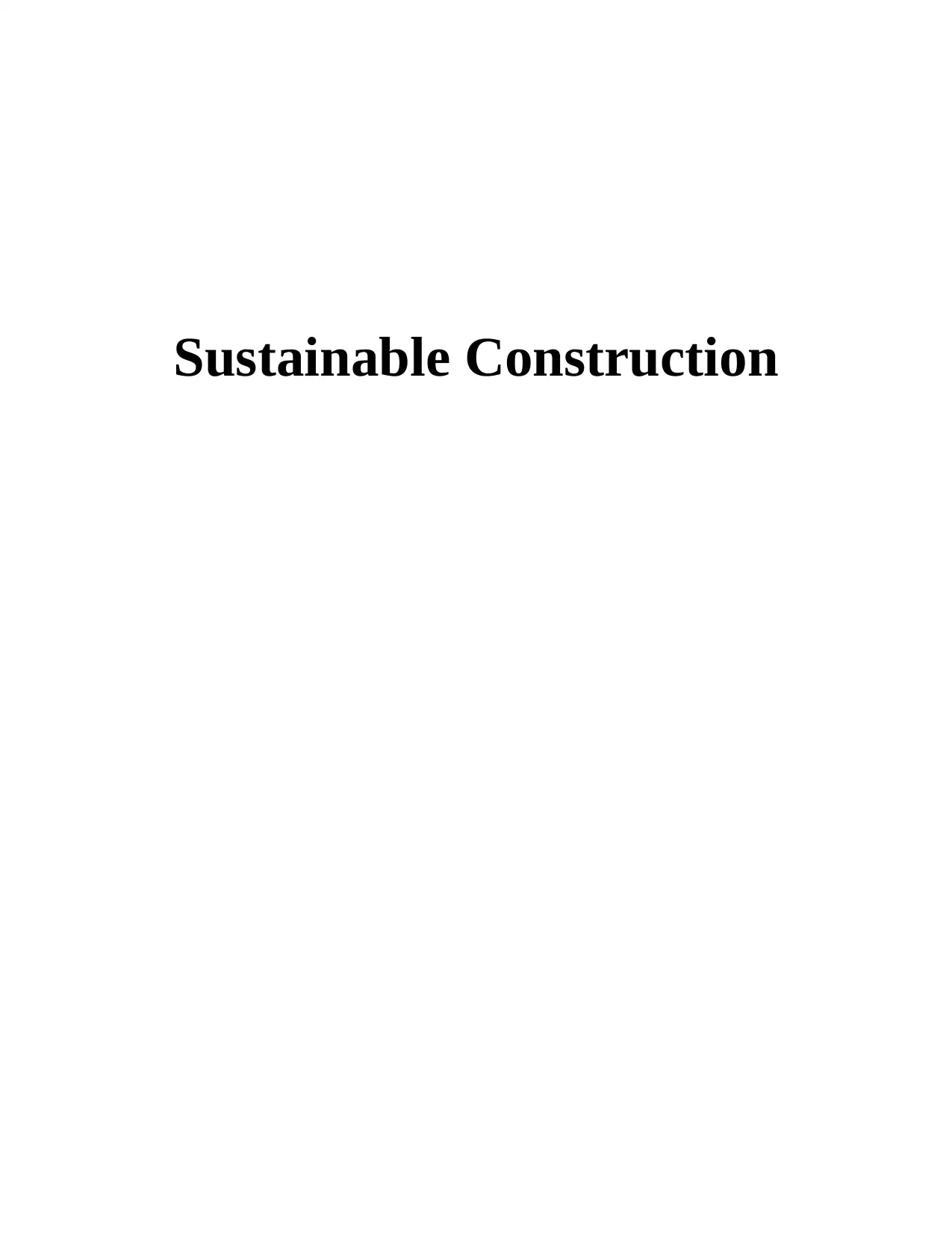
Sustainable Construction
Paraphrase This Document
Need a fresh take? Get an instant paraphrase of this document with our AI Paraphraser
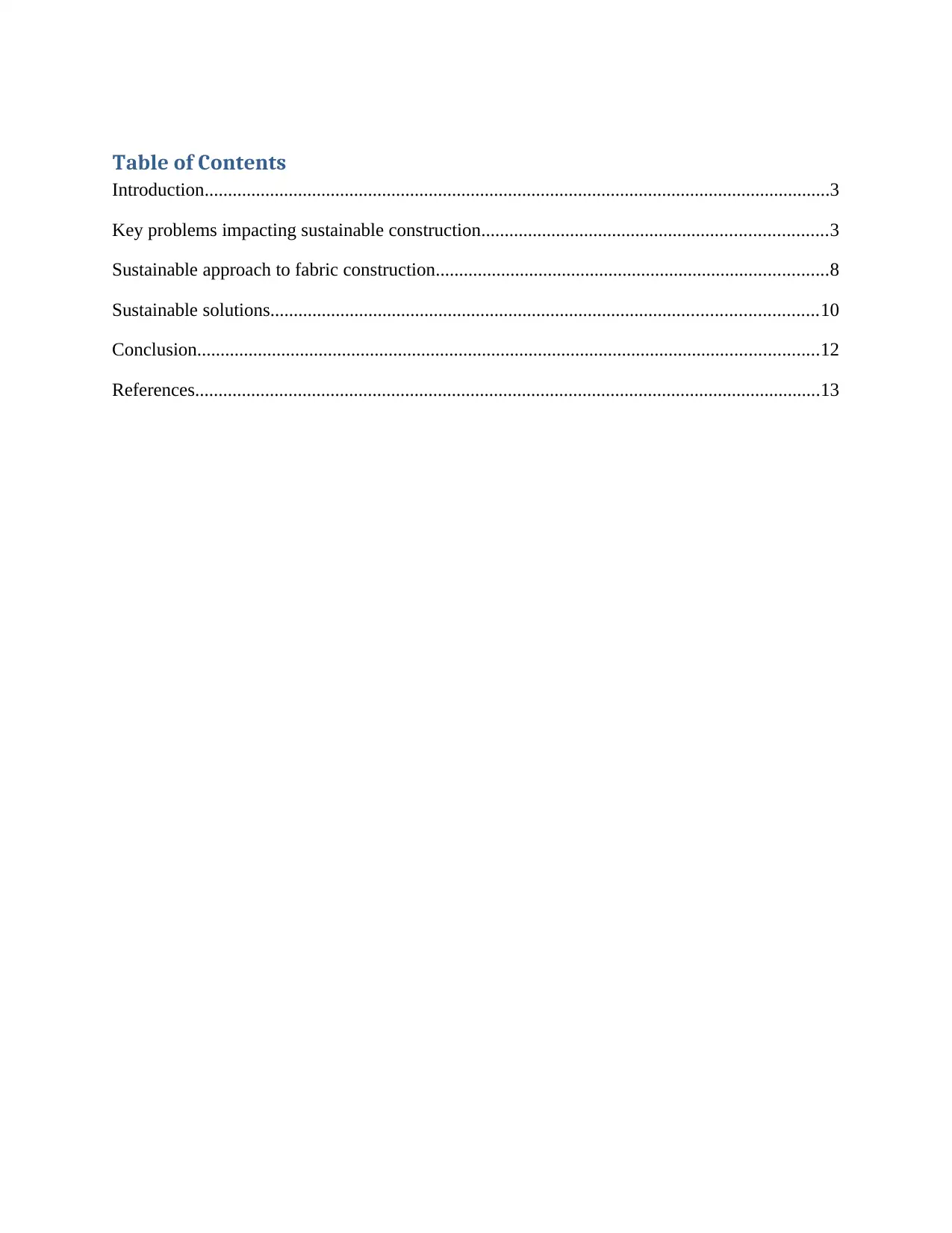
Table of Contents
Introduction......................................................................................................................................3
Key problems impacting sustainable construction..........................................................................3
Sustainable approach to fabric construction....................................................................................8
Sustainable solutions.....................................................................................................................10
Conclusion.....................................................................................................................................12
References......................................................................................................................................13
Introduction......................................................................................................................................3
Key problems impacting sustainable construction..........................................................................3
Sustainable approach to fabric construction....................................................................................8
Sustainable solutions.....................................................................................................................10
Conclusion.....................................................................................................................................12
References......................................................................................................................................13
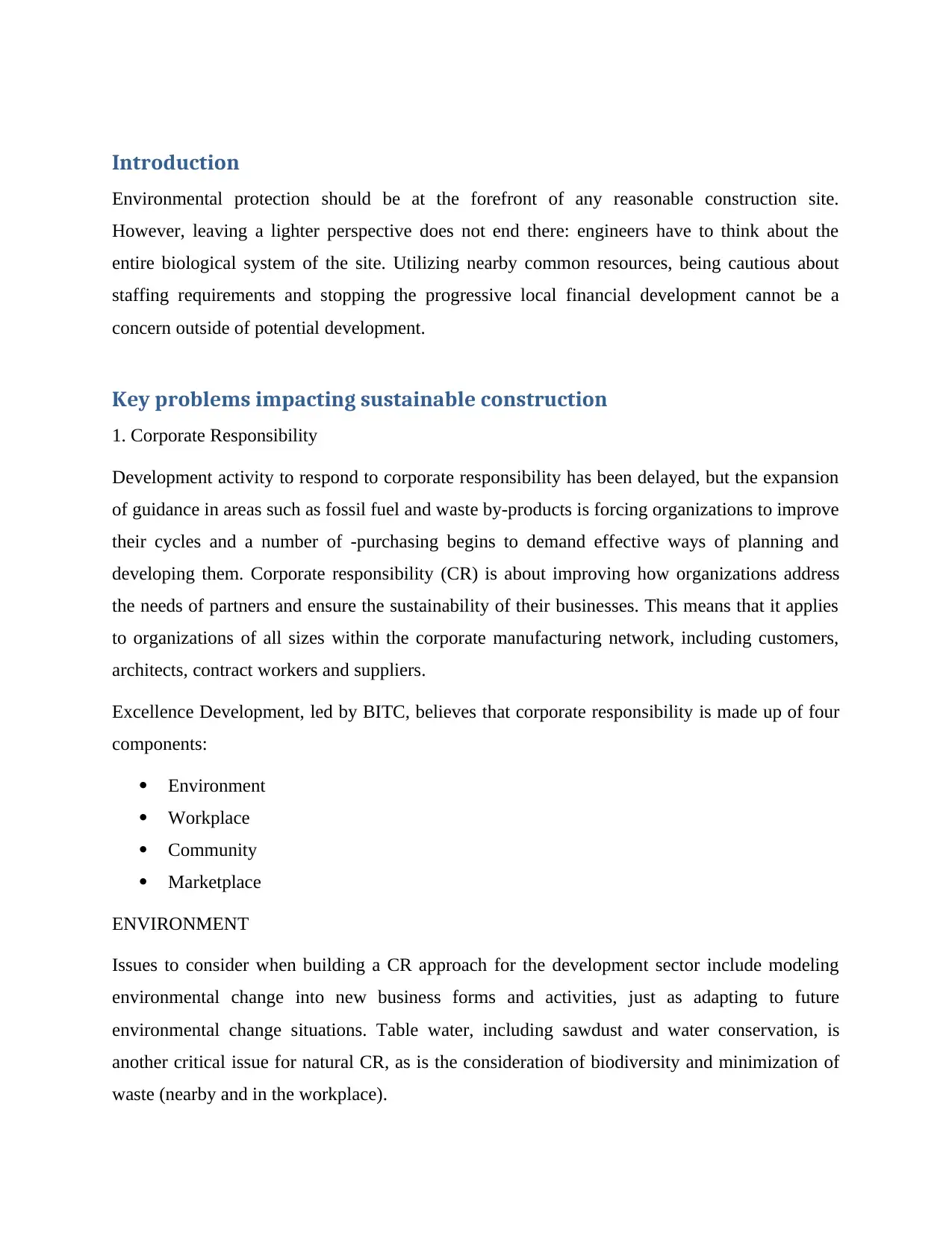
Introduction
Environmental protection should be at the forefront of any reasonable construction site.
However, leaving a lighter perspective does not end there: engineers have to think about the
entire biological system of the site. Utilizing nearby common resources, being cautious about
staffing requirements and stopping the progressive local financial development cannot be a
concern outside of potential development.
Key problems impacting sustainable construction
1. Corporate Responsibility
Development activity to respond to corporate responsibility has been delayed, but the expansion
of guidance in areas such as fossil fuel and waste by-products is forcing organizations to improve
their cycles and a number of -purchasing begins to demand effective ways of planning and
developing them. Corporate responsibility (CR) is about improving how organizations address
the needs of partners and ensure the sustainability of their businesses. This means that it applies
to organizations of all sizes within the corporate manufacturing network, including customers,
architects, contract workers and suppliers.
Excellence Development, led by BITC, believes that corporate responsibility is made up of four
components:
Environment
Workplace
Community
Marketplace
ENVIRONMENT
Issues to consider when building a CR approach for the development sector include modeling
environmental change into new business forms and activities, just as adapting to future
environmental change situations. Table water, including sawdust and water conservation, is
another critical issue for natural CR, as is the consideration of biodiversity and minimization of
waste (nearby and in the workplace).
Environmental protection should be at the forefront of any reasonable construction site.
However, leaving a lighter perspective does not end there: engineers have to think about the
entire biological system of the site. Utilizing nearby common resources, being cautious about
staffing requirements and stopping the progressive local financial development cannot be a
concern outside of potential development.
Key problems impacting sustainable construction
1. Corporate Responsibility
Development activity to respond to corporate responsibility has been delayed, but the expansion
of guidance in areas such as fossil fuel and waste by-products is forcing organizations to improve
their cycles and a number of -purchasing begins to demand effective ways of planning and
developing them. Corporate responsibility (CR) is about improving how organizations address
the needs of partners and ensure the sustainability of their businesses. This means that it applies
to organizations of all sizes within the corporate manufacturing network, including customers,
architects, contract workers and suppliers.
Excellence Development, led by BITC, believes that corporate responsibility is made up of four
components:
Environment
Workplace
Community
Marketplace
ENVIRONMENT
Issues to consider when building a CR approach for the development sector include modeling
environmental change into new business forms and activities, just as adapting to future
environmental change situations. Table water, including sawdust and water conservation, is
another critical issue for natural CR, as is the consideration of biodiversity and minimization of
waste (nearby and in the workplace).
⊘ This is a preview!⊘
Do you want full access?
Subscribe today to unlock all pages.

Trusted by 1+ million students worldwide
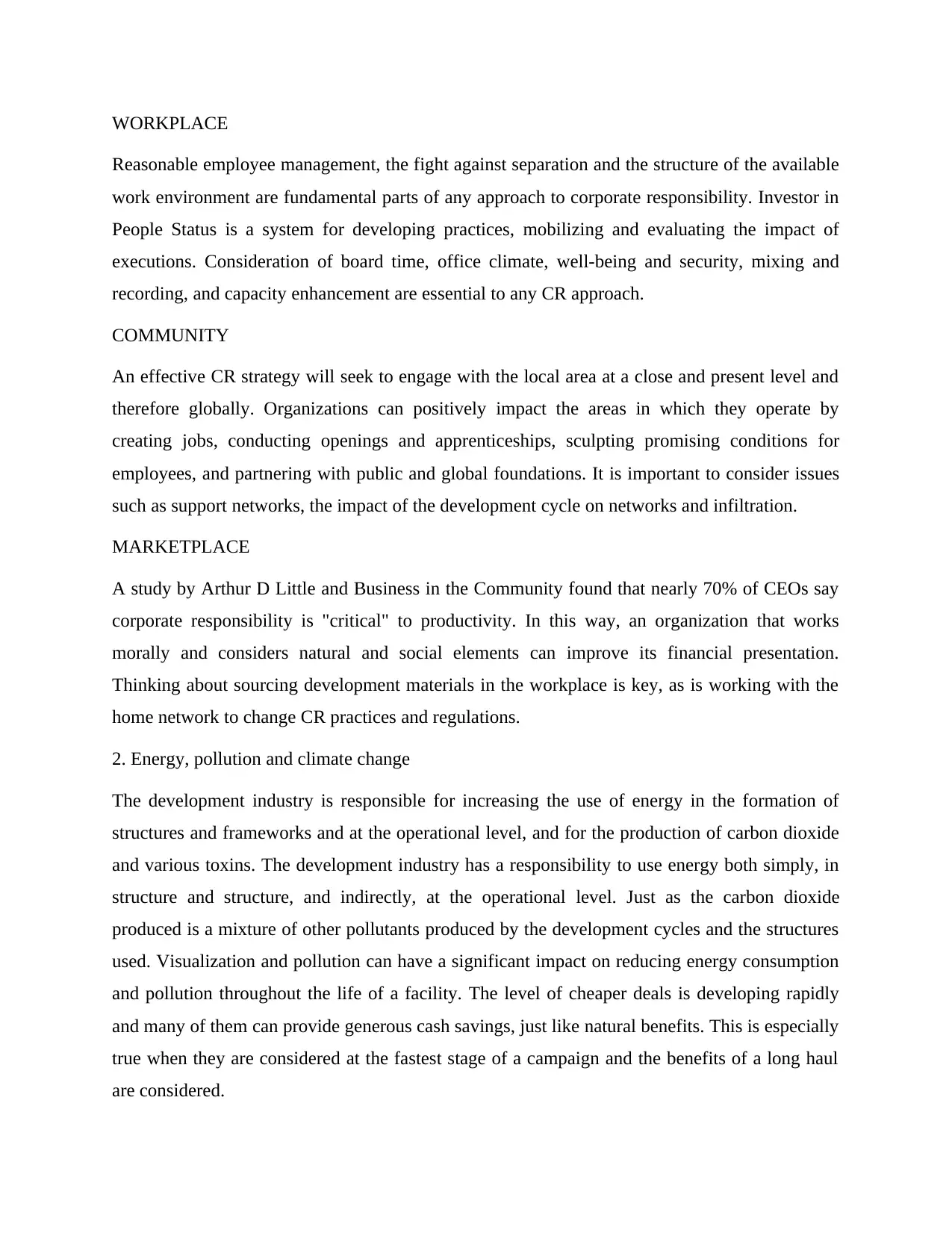
WORKPLACE
Reasonable employee management, the fight against separation and the structure of the available
work environment are fundamental parts of any approach to corporate responsibility. Investor in
People Status is a system for developing practices, mobilizing and evaluating the impact of
executions. Consideration of board time, office climate, well-being and security, mixing and
recording, and capacity enhancement are essential to any CR approach.
COMMUNITY
An effective CR strategy will seek to engage with the local area at a close and present level and
therefore globally. Organizations can positively impact the areas in which they operate by
creating jobs, conducting openings and apprenticeships, sculpting promising conditions for
employees, and partnering with public and global foundations. It is important to consider issues
such as support networks, the impact of the development cycle on networks and infiltration.
MARKETPLACE
A study by Arthur D Little and Business in the Community found that nearly 70% of CEOs say
corporate responsibility is "critical" to productivity. In this way, an organization that works
morally and considers natural and social elements can improve its financial presentation.
Thinking about sourcing development materials in the workplace is key, as is working with the
home network to change CR practices and regulations.
2. Energy, pollution and climate change
The development industry is responsible for increasing the use of energy in the formation of
structures and frameworks and at the operational level, and for the production of carbon dioxide
and various toxins. The development industry has a responsibility to use energy both simply, in
structure and structure, and indirectly, at the operational level. Just as the carbon dioxide
produced is a mixture of other pollutants produced by the development cycles and the structures
used. Visualization and pollution can have a significant impact on reducing energy consumption
and pollution throughout the life of a facility. The level of cheaper deals is developing rapidly
and many of them can provide generous cash savings, just like natural benefits. This is especially
true when they are considered at the fastest stage of a campaign and the benefits of a long haul
are considered.
Reasonable employee management, the fight against separation and the structure of the available
work environment are fundamental parts of any approach to corporate responsibility. Investor in
People Status is a system for developing practices, mobilizing and evaluating the impact of
executions. Consideration of board time, office climate, well-being and security, mixing and
recording, and capacity enhancement are essential to any CR approach.
COMMUNITY
An effective CR strategy will seek to engage with the local area at a close and present level and
therefore globally. Organizations can positively impact the areas in which they operate by
creating jobs, conducting openings and apprenticeships, sculpting promising conditions for
employees, and partnering with public and global foundations. It is important to consider issues
such as support networks, the impact of the development cycle on networks and infiltration.
MARKETPLACE
A study by Arthur D Little and Business in the Community found that nearly 70% of CEOs say
corporate responsibility is "critical" to productivity. In this way, an organization that works
morally and considers natural and social elements can improve its financial presentation.
Thinking about sourcing development materials in the workplace is key, as is working with the
home network to change CR practices and regulations.
2. Energy, pollution and climate change
The development industry is responsible for increasing the use of energy in the formation of
structures and frameworks and at the operational level, and for the production of carbon dioxide
and various toxins. The development industry has a responsibility to use energy both simply, in
structure and structure, and indirectly, at the operational level. Just as the carbon dioxide
produced is a mixture of other pollutants produced by the development cycles and the structures
used. Visualization and pollution can have a significant impact on reducing energy consumption
and pollution throughout the life of a facility. The level of cheaper deals is developing rapidly
and many of them can provide generous cash savings, just like natural benefits. This is especially
true when they are considered at the fastest stage of a campaign and the benefits of a long haul
are considered.
Paraphrase This Document
Need a fresh take? Get an instant paraphrase of this document with our AI Paraphraser
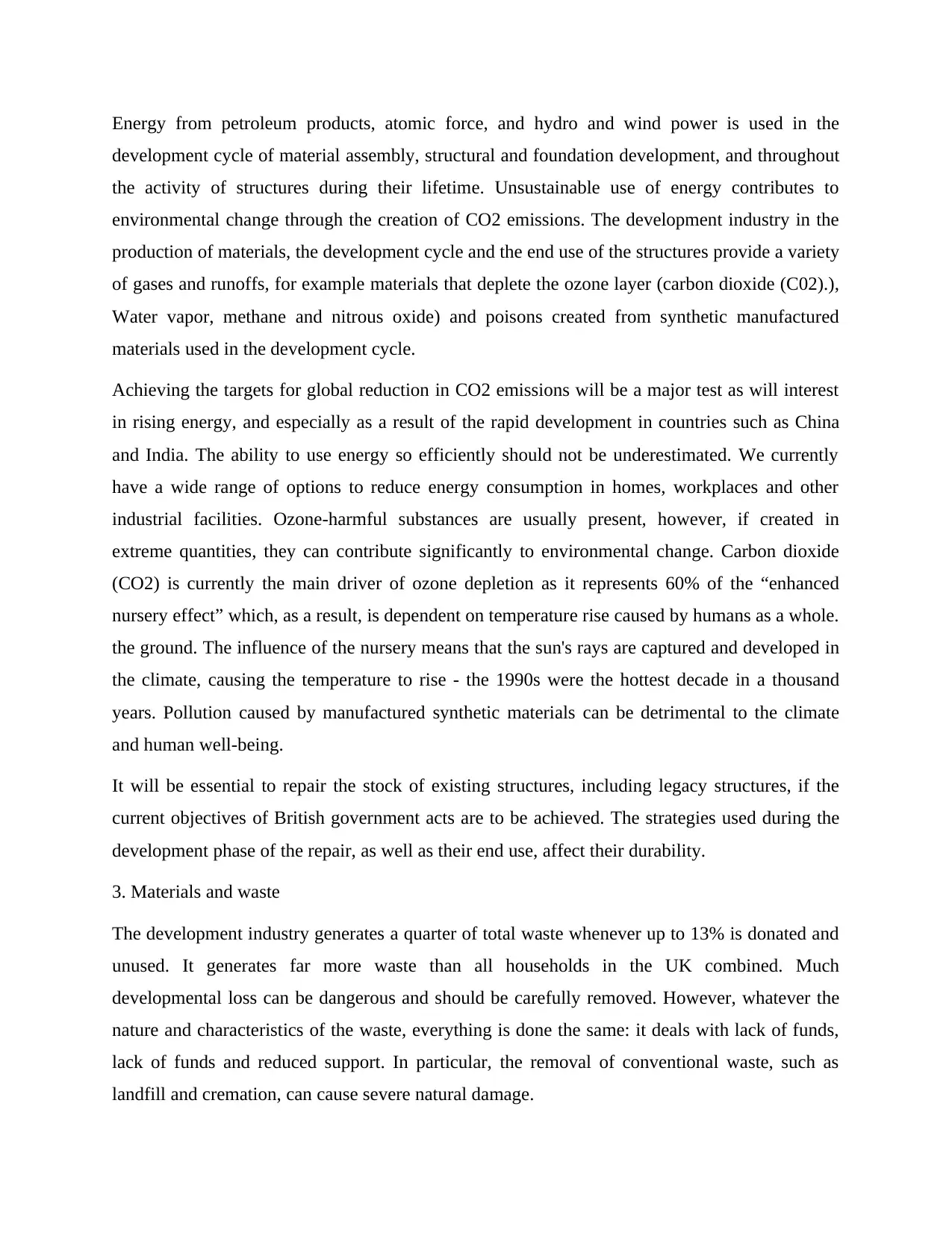
Energy from petroleum products, atomic force, and hydro and wind power is used in the
development cycle of material assembly, structural and foundation development, and throughout
the activity of structures during their lifetime. Unsustainable use of energy contributes to
environmental change through the creation of CO2 emissions. The development industry in the
production of materials, the development cycle and the end use of the structures provide a variety
of gases and runoffs, for example materials that deplete the ozone layer (carbon dioxide (C02).),
Water vapor, methane and nitrous oxide) and poisons created from synthetic manufactured
materials used in the development cycle.
Achieving the targets for global reduction in CO2 emissions will be a major test as will interest
in rising energy, and especially as a result of the rapid development in countries such as China
and India. The ability to use energy so efficiently should not be underestimated. We currently
have a wide range of options to reduce energy consumption in homes, workplaces and other
industrial facilities. Ozone-harmful substances are usually present, however, if created in
extreme quantities, they can contribute significantly to environmental change. Carbon dioxide
(CO2) is currently the main driver of ozone depletion as it represents 60% of the “enhanced
nursery effect” which, as a result, is dependent on temperature rise caused by humans as a whole.
the ground. The influence of the nursery means that the sun's rays are captured and developed in
the climate, causing the temperature to rise - the 1990s were the hottest decade in a thousand
years. Pollution caused by manufactured synthetic materials can be detrimental to the climate
and human well-being.
It will be essential to repair the stock of existing structures, including legacy structures, if the
current objectives of British government acts are to be achieved. The strategies used during the
development phase of the repair, as well as their end use, affect their durability.
3. Materials and waste
The development industry generates a quarter of total waste whenever up to 13% is donated and
unused. It generates far more waste than all households in the UK combined. Much
developmental loss can be dangerous and should be carefully removed. However, whatever the
nature and characteristics of the waste, everything is done the same: it deals with lack of funds,
lack of funds and reduced support. In particular, the removal of conventional waste, such as
landfill and cremation, can cause severe natural damage.
development cycle of material assembly, structural and foundation development, and throughout
the activity of structures during their lifetime. Unsustainable use of energy contributes to
environmental change through the creation of CO2 emissions. The development industry in the
production of materials, the development cycle and the end use of the structures provide a variety
of gases and runoffs, for example materials that deplete the ozone layer (carbon dioxide (C02).),
Water vapor, methane and nitrous oxide) and poisons created from synthetic manufactured
materials used in the development cycle.
Achieving the targets for global reduction in CO2 emissions will be a major test as will interest
in rising energy, and especially as a result of the rapid development in countries such as China
and India. The ability to use energy so efficiently should not be underestimated. We currently
have a wide range of options to reduce energy consumption in homes, workplaces and other
industrial facilities. Ozone-harmful substances are usually present, however, if created in
extreme quantities, they can contribute significantly to environmental change. Carbon dioxide
(CO2) is currently the main driver of ozone depletion as it represents 60% of the “enhanced
nursery effect” which, as a result, is dependent on temperature rise caused by humans as a whole.
the ground. The influence of the nursery means that the sun's rays are captured and developed in
the climate, causing the temperature to rise - the 1990s were the hottest decade in a thousand
years. Pollution caused by manufactured synthetic materials can be detrimental to the climate
and human well-being.
It will be essential to repair the stock of existing structures, including legacy structures, if the
current objectives of British government acts are to be achieved. The strategies used during the
development phase of the repair, as well as their end use, affect their durability.
3. Materials and waste
The development industry generates a quarter of total waste whenever up to 13% is donated and
unused. It generates far more waste than all households in the UK combined. Much
developmental loss can be dangerous and should be carefully removed. However, whatever the
nature and characteristics of the waste, everything is done the same: it deals with lack of funds,
lack of funds and reduced support. In particular, the removal of conventional waste, such as
landfill and cremation, can cause severe natural damage.
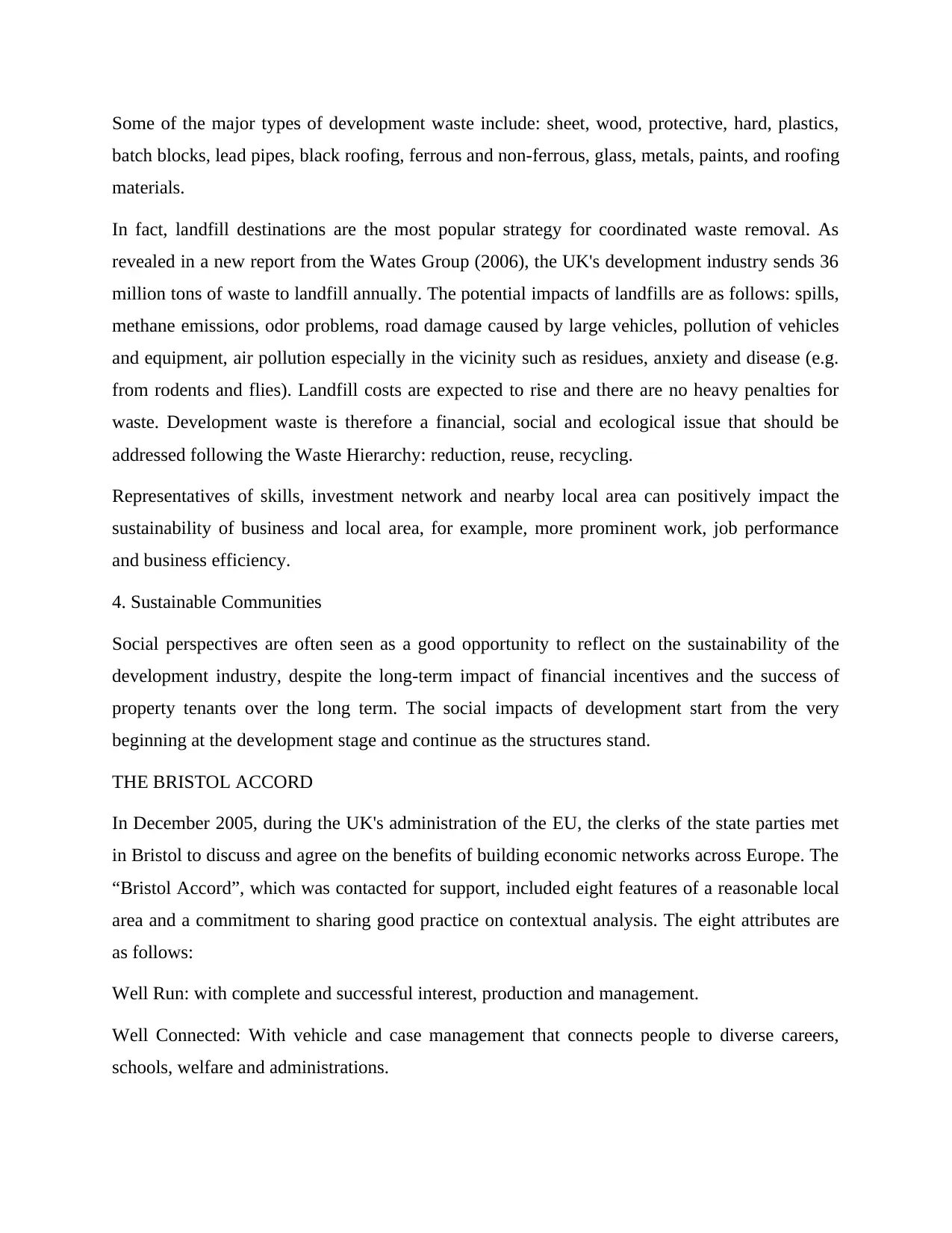
Some of the major types of development waste include: sheet, wood, protective, hard, plastics,
batch blocks, lead pipes, black roofing, ferrous and non-ferrous, glass, metals, paints, and roofing
materials.
In fact, landfill destinations are the most popular strategy for coordinated waste removal. As
revealed in a new report from the Wates Group (2006), the UK's development industry sends 36
million tons of waste to landfill annually. The potential impacts of landfills are as follows: spills,
methane emissions, odor problems, road damage caused by large vehicles, pollution of vehicles
and equipment, air pollution especially in the vicinity such as residues, anxiety and disease (e.g.
from rodents and flies). Landfill costs are expected to rise and there are no heavy penalties for
waste. Development waste is therefore a financial, social and ecological issue that should be
addressed following the Waste Hierarchy: reduction, reuse, recycling.
Representatives of skills, investment network and nearby local area can positively impact the
sustainability of business and local area, for example, more prominent work, job performance
and business efficiency.
4. Sustainable Communities
Social perspectives are often seen as a good opportunity to reflect on the sustainability of the
development industry, despite the long-term impact of financial incentives and the success of
property tenants over the long term. The social impacts of development start from the very
beginning at the development stage and continue as the structures stand.
THE BRISTOL ACCORD
In December 2005, during the UK's administration of the EU, the clerks of the state parties met
in Bristol to discuss and agree on the benefits of building economic networks across Europe. The
“Bristol Accord”, which was contacted for support, included eight features of a reasonable local
area and a commitment to sharing good practice on contextual analysis. The eight attributes are
as follows:
Well Run: with complete and successful interest, production and management.
Well Connected: With vehicle and case management that connects people to diverse careers,
schools, welfare and administrations.
batch blocks, lead pipes, black roofing, ferrous and non-ferrous, glass, metals, paints, and roofing
materials.
In fact, landfill destinations are the most popular strategy for coordinated waste removal. As
revealed in a new report from the Wates Group (2006), the UK's development industry sends 36
million tons of waste to landfill annually. The potential impacts of landfills are as follows: spills,
methane emissions, odor problems, road damage caused by large vehicles, pollution of vehicles
and equipment, air pollution especially in the vicinity such as residues, anxiety and disease (e.g.
from rodents and flies). Landfill costs are expected to rise and there are no heavy penalties for
waste. Development waste is therefore a financial, social and ecological issue that should be
addressed following the Waste Hierarchy: reduction, reuse, recycling.
Representatives of skills, investment network and nearby local area can positively impact the
sustainability of business and local area, for example, more prominent work, job performance
and business efficiency.
4. Sustainable Communities
Social perspectives are often seen as a good opportunity to reflect on the sustainability of the
development industry, despite the long-term impact of financial incentives and the success of
property tenants over the long term. The social impacts of development start from the very
beginning at the development stage and continue as the structures stand.
THE BRISTOL ACCORD
In December 2005, during the UK's administration of the EU, the clerks of the state parties met
in Bristol to discuss and agree on the benefits of building economic networks across Europe. The
“Bristol Accord”, which was contacted for support, included eight features of a reasonable local
area and a commitment to sharing good practice on contextual analysis. The eight attributes are
as follows:
Well Run: with complete and successful interest, production and management.
Well Connected: With vehicle and case management that connects people to diverse careers,
schools, welfare and administrations.
⊘ This is a preview!⊘
Do you want full access?
Subscribe today to unlock all pages.

Trusted by 1+ million students worldwide
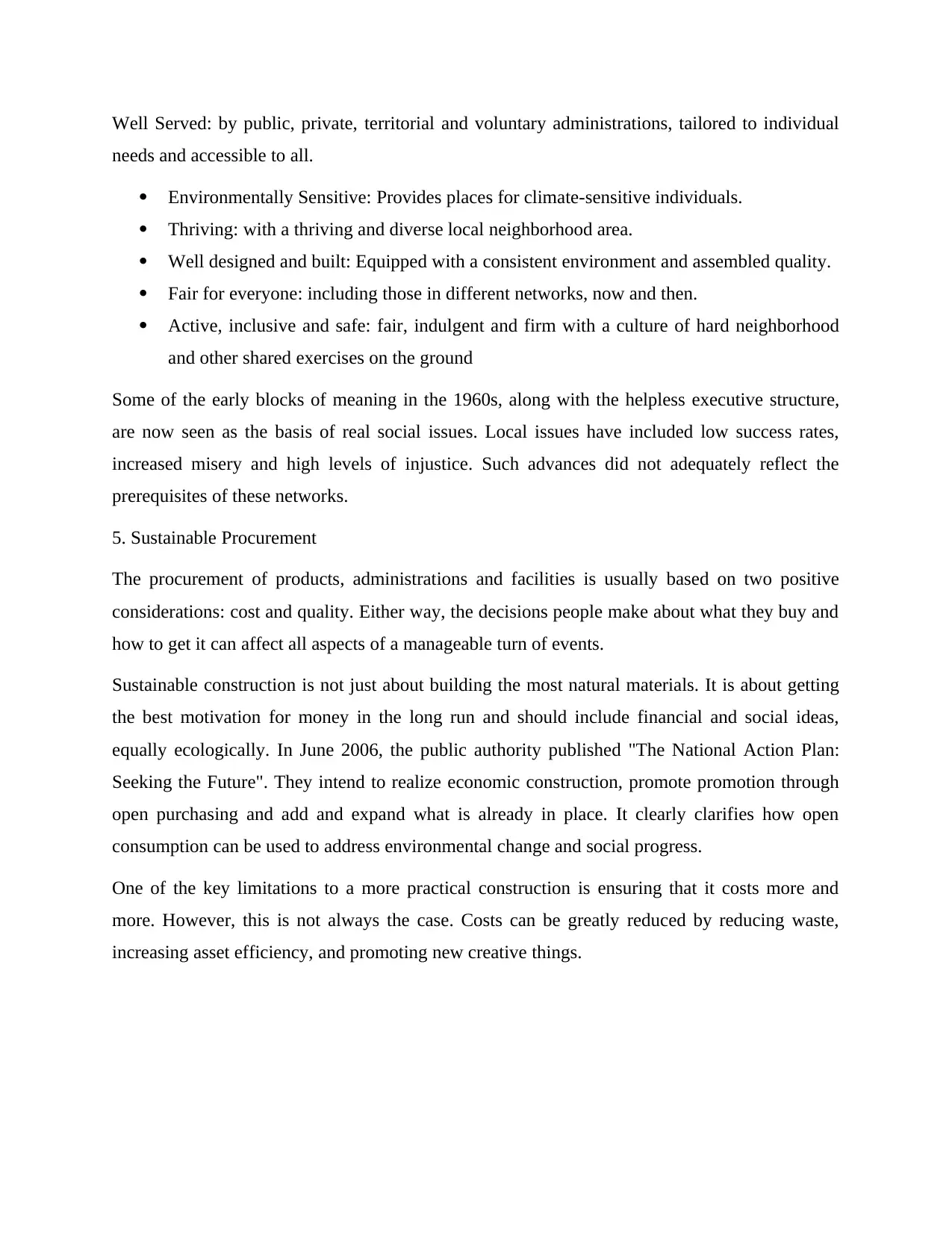
Well Served: by public, private, territorial and voluntary administrations, tailored to individual
needs and accessible to all.
Environmentally Sensitive: Provides places for climate-sensitive individuals.
Thriving: with a thriving and diverse local neighborhood area.
Well designed and built: Equipped with a consistent environment and assembled quality.
Fair for everyone: including those in different networks, now and then.
Active, inclusive and safe: fair, indulgent and firm with a culture of hard neighborhood
and other shared exercises on the ground
Some of the early blocks of meaning in the 1960s, along with the helpless executive structure,
are now seen as the basis of real social issues. Local issues have included low success rates,
increased misery and high levels of injustice. Such advances did not adequately reflect the
prerequisites of these networks.
5. Sustainable Procurement
The procurement of products, administrations and facilities is usually based on two positive
considerations: cost and quality. Either way, the decisions people make about what they buy and
how to get it can affect all aspects of a manageable turn of events.
Sustainable construction is not just about building the most natural materials. It is about getting
the best motivation for money in the long run and should include financial and social ideas,
equally ecologically. In June 2006, the public authority published "The National Action Plan:
Seeking the Future". They intend to realize economic construction, promote promotion through
open purchasing and add and expand what is already in place. It clearly clarifies how open
consumption can be used to address environmental change and social progress.
One of the key limitations to a more practical construction is ensuring that it costs more and
more. However, this is not always the case. Costs can be greatly reduced by reducing waste,
increasing asset efficiency, and promoting new creative things.
needs and accessible to all.
Environmentally Sensitive: Provides places for climate-sensitive individuals.
Thriving: with a thriving and diverse local neighborhood area.
Well designed and built: Equipped with a consistent environment and assembled quality.
Fair for everyone: including those in different networks, now and then.
Active, inclusive and safe: fair, indulgent and firm with a culture of hard neighborhood
and other shared exercises on the ground
Some of the early blocks of meaning in the 1960s, along with the helpless executive structure,
are now seen as the basis of real social issues. Local issues have included low success rates,
increased misery and high levels of injustice. Such advances did not adequately reflect the
prerequisites of these networks.
5. Sustainable Procurement
The procurement of products, administrations and facilities is usually based on two positive
considerations: cost and quality. Either way, the decisions people make about what they buy and
how to get it can affect all aspects of a manageable turn of events.
Sustainable construction is not just about building the most natural materials. It is about getting
the best motivation for money in the long run and should include financial and social ideas,
equally ecologically. In June 2006, the public authority published "The National Action Plan:
Seeking the Future". They intend to realize economic construction, promote promotion through
open purchasing and add and expand what is already in place. It clearly clarifies how open
consumption can be used to address environmental change and social progress.
One of the key limitations to a more practical construction is ensuring that it costs more and
more. However, this is not always the case. Costs can be greatly reduced by reducing waste,
increasing asset efficiency, and promoting new creative things.
Paraphrase This Document
Need a fresh take? Get an instant paraphrase of this document with our AI Paraphraser
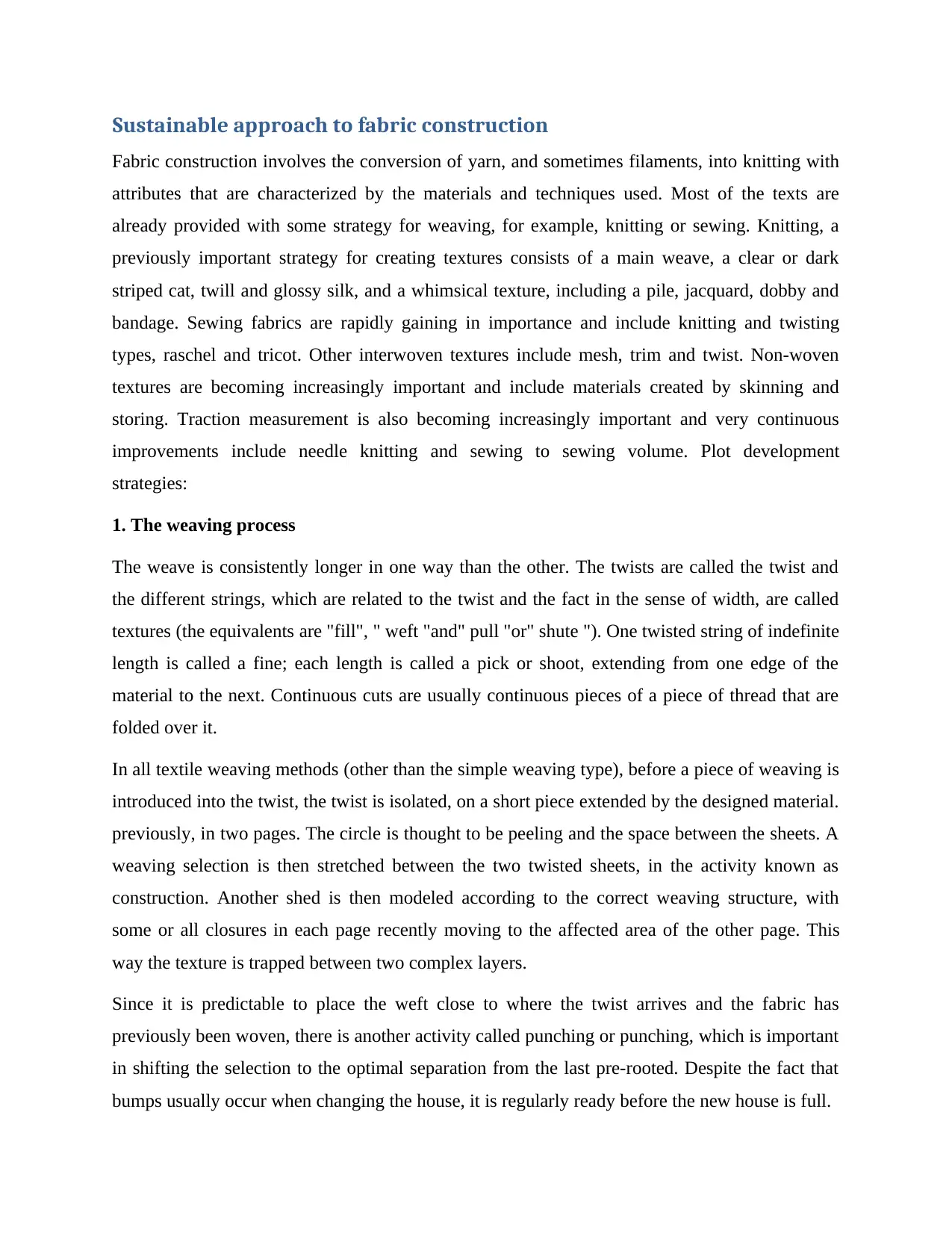
Sustainable approach to fabric construction
Fabric construction involves the conversion of yarn, and sometimes filaments, into knitting with
attributes that are characterized by the materials and techniques used. Most of the texts are
already provided with some strategy for weaving, for example, knitting or sewing. Knitting, a
previously important strategy for creating textures consists of a main weave, a clear or dark
striped cat, twill and glossy silk, and a whimsical texture, including a pile, jacquard, dobby and
bandage. Sewing fabrics are rapidly gaining in importance and include knitting and twisting
types, raschel and tricot. Other interwoven textures include mesh, trim and twist. Non-woven
textures are becoming increasingly important and include materials created by skinning and
storing. Traction measurement is also becoming increasingly important and very continuous
improvements include needle knitting and sewing to sewing volume. Plot development
strategies:
1. The weaving process
The weave is consistently longer in one way than the other. The twists are called the twist and
the different strings, which are related to the twist and the fact in the sense of width, are called
textures (the equivalents are "fill", " weft "and" pull "or" shute "). One twisted string of indefinite
length is called a fine; each length is called a pick or shoot, extending from one edge of the
material to the next. Continuous cuts are usually continuous pieces of a piece of thread that are
folded over it.
In all textile weaving methods (other than the simple weaving type), before a piece of weaving is
introduced into the twist, the twist is isolated, on a short piece extended by the designed material.
previously, in two pages. The circle is thought to be peeling and the space between the sheets. A
weaving selection is then stretched between the two twisted sheets, in the activity known as
construction. Another shed is then modeled according to the correct weaving structure, with
some or all closures in each page recently moving to the affected area of the other page. This
way the texture is trapped between two complex layers.
Since it is predictable to place the weft close to where the twist arrives and the fabric has
previously been woven, there is another activity called punching or punching, which is important
in shifting the selection to the optimal separation from the last pre-rooted. Despite the fact that
bumps usually occur when changing the house, it is regularly ready before the new house is full.
Fabric construction involves the conversion of yarn, and sometimes filaments, into knitting with
attributes that are characterized by the materials and techniques used. Most of the texts are
already provided with some strategy for weaving, for example, knitting or sewing. Knitting, a
previously important strategy for creating textures consists of a main weave, a clear or dark
striped cat, twill and glossy silk, and a whimsical texture, including a pile, jacquard, dobby and
bandage. Sewing fabrics are rapidly gaining in importance and include knitting and twisting
types, raschel and tricot. Other interwoven textures include mesh, trim and twist. Non-woven
textures are becoming increasingly important and include materials created by skinning and
storing. Traction measurement is also becoming increasingly important and very continuous
improvements include needle knitting and sewing to sewing volume. Plot development
strategies:
1. The weaving process
The weave is consistently longer in one way than the other. The twists are called the twist and
the different strings, which are related to the twist and the fact in the sense of width, are called
textures (the equivalents are "fill", " weft "and" pull "or" shute "). One twisted string of indefinite
length is called a fine; each length is called a pick or shoot, extending from one edge of the
material to the next. Continuous cuts are usually continuous pieces of a piece of thread that are
folded over it.
In all textile weaving methods (other than the simple weaving type), before a piece of weaving is
introduced into the twist, the twist is isolated, on a short piece extended by the designed material.
previously, in two pages. The circle is thought to be peeling and the space between the sheets. A
weaving selection is then stretched between the two twisted sheets, in the activity known as
construction. Another shed is then modeled according to the correct weaving structure, with
some or all closures in each page recently moving to the affected area of the other page. This
way the texture is trapped between two complex layers.
Since it is predictable to place the weft close to where the twist arrives and the fabric has
previously been woven, there is another activity called punching or punching, which is important
in shifting the selection to the optimal separation from the last pre-rooted. Despite the fact that
bumps usually occur when changing the house, it is regularly ready before the new house is full.
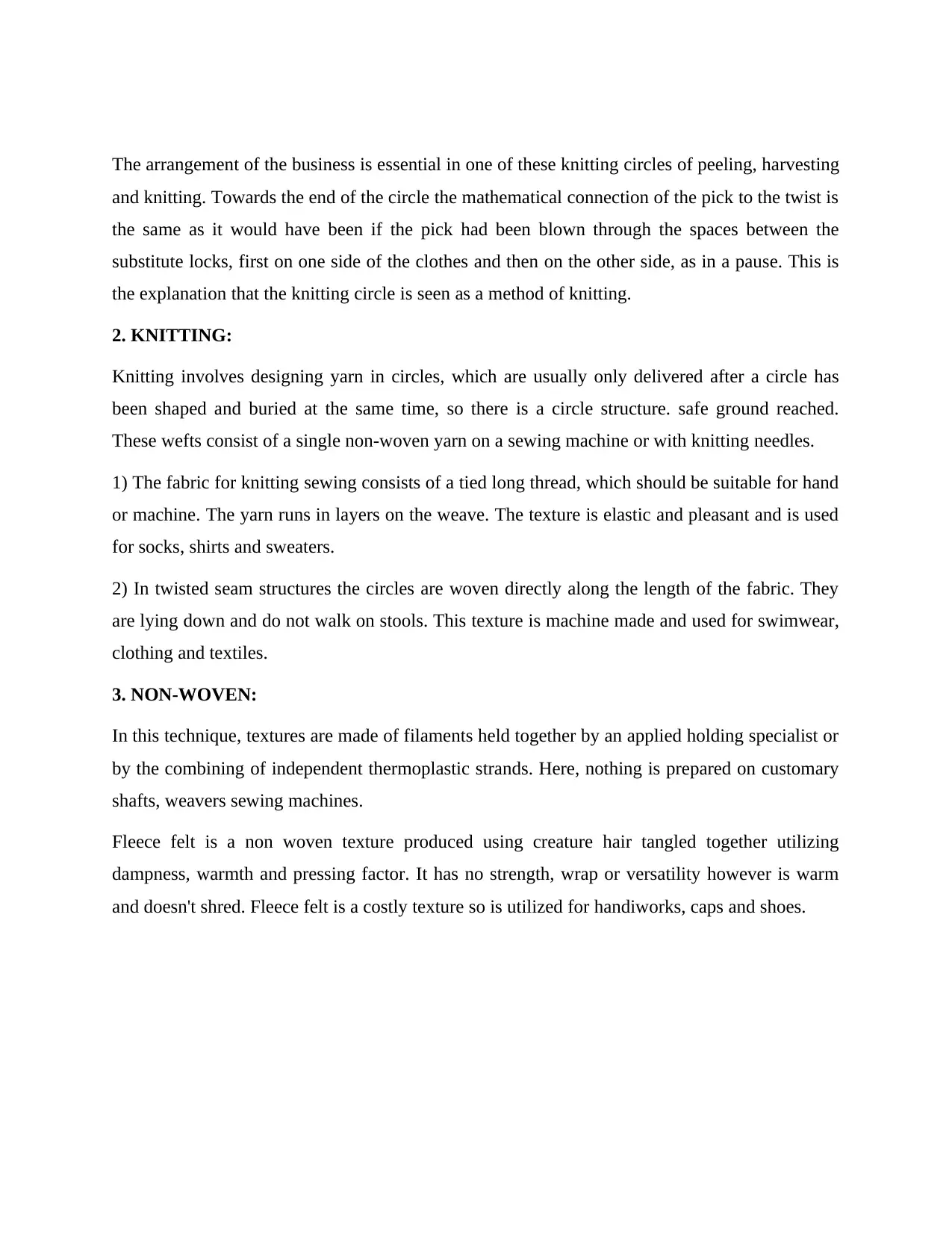
The arrangement of the business is essential in one of these knitting circles of peeling, harvesting
and knitting. Towards the end of the circle the mathematical connection of the pick to the twist is
the same as it would have been if the pick had been blown through the spaces between the
substitute locks, first on one side of the clothes and then on the other side, as in a pause. This is
the explanation that the knitting circle is seen as a method of knitting.
2. KNITTING:
Knitting involves designing yarn in circles, which are usually only delivered after a circle has
been shaped and buried at the same time, so there is a circle structure. safe ground reached.
These wefts consist of a single non-woven yarn on a sewing machine or with knitting needles.
1) The fabric for knitting sewing consists of a tied long thread, which should be suitable for hand
or machine. The yarn runs in layers on the weave. The texture is elastic and pleasant and is used
for socks, shirts and sweaters.
2) In twisted seam structures the circles are woven directly along the length of the fabric. They
are lying down and do not walk on stools. This texture is machine made and used for swimwear,
clothing and textiles.
3. NON-WOVEN:
In this technique, textures are made of filaments held together by an applied holding specialist or
by the combining of independent thermoplastic strands. Here, nothing is prepared on customary
shafts, weavers sewing machines.
Fleece felt is a non woven texture produced using creature hair tangled together utilizing
dampness, warmth and pressing factor. It has no strength, wrap or versatility however is warm
and doesn't shred. Fleece felt is a costly texture so is utilized for handiworks, caps and shoes.
and knitting. Towards the end of the circle the mathematical connection of the pick to the twist is
the same as it would have been if the pick had been blown through the spaces between the
substitute locks, first on one side of the clothes and then on the other side, as in a pause. This is
the explanation that the knitting circle is seen as a method of knitting.
2. KNITTING:
Knitting involves designing yarn in circles, which are usually only delivered after a circle has
been shaped and buried at the same time, so there is a circle structure. safe ground reached.
These wefts consist of a single non-woven yarn on a sewing machine or with knitting needles.
1) The fabric for knitting sewing consists of a tied long thread, which should be suitable for hand
or machine. The yarn runs in layers on the weave. The texture is elastic and pleasant and is used
for socks, shirts and sweaters.
2) In twisted seam structures the circles are woven directly along the length of the fabric. They
are lying down and do not walk on stools. This texture is machine made and used for swimwear,
clothing and textiles.
3. NON-WOVEN:
In this technique, textures are made of filaments held together by an applied holding specialist or
by the combining of independent thermoplastic strands. Here, nothing is prepared on customary
shafts, weavers sewing machines.
Fleece felt is a non woven texture produced using creature hair tangled together utilizing
dampness, warmth and pressing factor. It has no strength, wrap or versatility however is warm
and doesn't shred. Fleece felt is a costly texture so is utilized for handiworks, caps and shoes.
⊘ This is a preview!⊘
Do you want full access?
Subscribe today to unlock all pages.

Trusted by 1+ million students worldwide
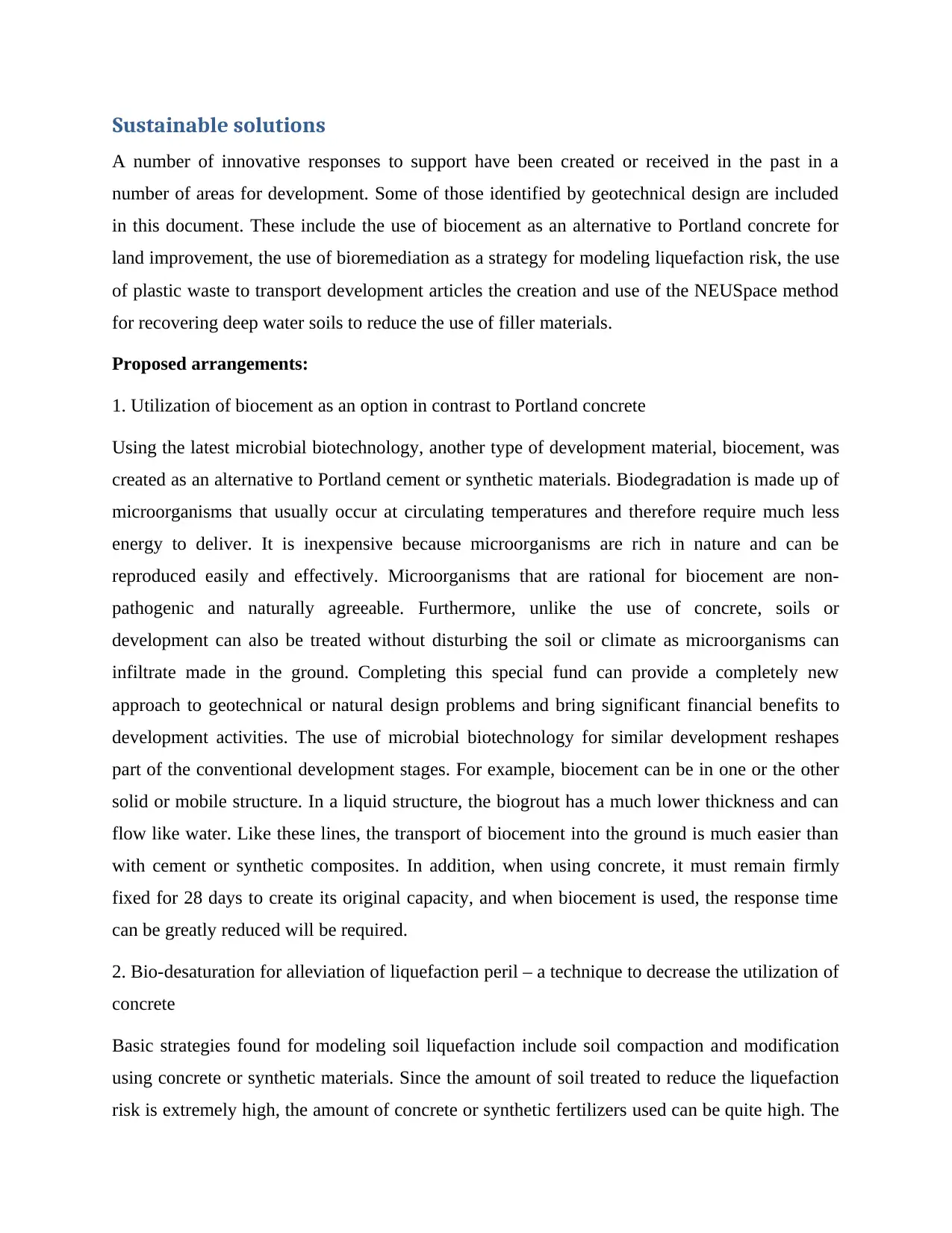
Sustainable solutions
A number of innovative responses to support have been created or received in the past in a
number of areas for development. Some of those identified by geotechnical design are included
in this document. These include the use of biocement as an alternative to Portland concrete for
land improvement, the use of bioremediation as a strategy for modeling liquefaction risk, the use
of plastic waste to transport development articles the creation and use of the NEUSpace method
for recovering deep water soils to reduce the use of filler materials.
Proposed arrangements:
1. Utilization of biocement as an option in contrast to Portland concrete
Using the latest microbial biotechnology, another type of development material, biocement, was
created as an alternative to Portland cement or synthetic materials. Biodegradation is made up of
microorganisms that usually occur at circulating temperatures and therefore require much less
energy to deliver. It is inexpensive because microorganisms are rich in nature and can be
reproduced easily and effectively. Microorganisms that are rational for biocement are non-
pathogenic and naturally agreeable. Furthermore, unlike the use of concrete, soils or
development can also be treated without disturbing the soil or climate as microorganisms can
infiltrate made in the ground. Completing this special fund can provide a completely new
approach to geotechnical or natural design problems and bring significant financial benefits to
development activities. The use of microbial biotechnology for similar development reshapes
part of the conventional development stages. For example, biocement can be in one or the other
solid or mobile structure. In a liquid structure, the biogrout has a much lower thickness and can
flow like water. Like these lines, the transport of biocement into the ground is much easier than
with cement or synthetic composites. In addition, when using concrete, it must remain firmly
fixed for 28 days to create its original capacity, and when biocement is used, the response time
can be greatly reduced will be required.
2. Bio-desaturation for alleviation of liquefaction peril – a technique to decrease the utilization of
concrete
Basic strategies found for modeling soil liquefaction include soil compaction and modification
using concrete or synthetic materials. Since the amount of soil treated to reduce the liquefaction
risk is extremely high, the amount of concrete or synthetic fertilizers used can be quite high. The
A number of innovative responses to support have been created or received in the past in a
number of areas for development. Some of those identified by geotechnical design are included
in this document. These include the use of biocement as an alternative to Portland concrete for
land improvement, the use of bioremediation as a strategy for modeling liquefaction risk, the use
of plastic waste to transport development articles the creation and use of the NEUSpace method
for recovering deep water soils to reduce the use of filler materials.
Proposed arrangements:
1. Utilization of biocement as an option in contrast to Portland concrete
Using the latest microbial biotechnology, another type of development material, biocement, was
created as an alternative to Portland cement or synthetic materials. Biodegradation is made up of
microorganisms that usually occur at circulating temperatures and therefore require much less
energy to deliver. It is inexpensive because microorganisms are rich in nature and can be
reproduced easily and effectively. Microorganisms that are rational for biocement are non-
pathogenic and naturally agreeable. Furthermore, unlike the use of concrete, soils or
development can also be treated without disturbing the soil or climate as microorganisms can
infiltrate made in the ground. Completing this special fund can provide a completely new
approach to geotechnical or natural design problems and bring significant financial benefits to
development activities. The use of microbial biotechnology for similar development reshapes
part of the conventional development stages. For example, biocement can be in one or the other
solid or mobile structure. In a liquid structure, the biogrout has a much lower thickness and can
flow like water. Like these lines, the transport of biocement into the ground is much easier than
with cement or synthetic composites. In addition, when using concrete, it must remain firmly
fixed for 28 days to create its original capacity, and when biocement is used, the response time
can be greatly reduced will be required.
2. Bio-desaturation for alleviation of liquefaction peril – a technique to decrease the utilization of
concrete
Basic strategies found for modeling soil liquefaction include soil compaction and modification
using concrete or synthetic materials. Since the amount of soil treated to reduce the liquefaction
risk is extremely high, the amount of concrete or synthetic fertilizers used can be quite high. The
Paraphrase This Document
Need a fresh take? Get an instant paraphrase of this document with our AI Paraphraser
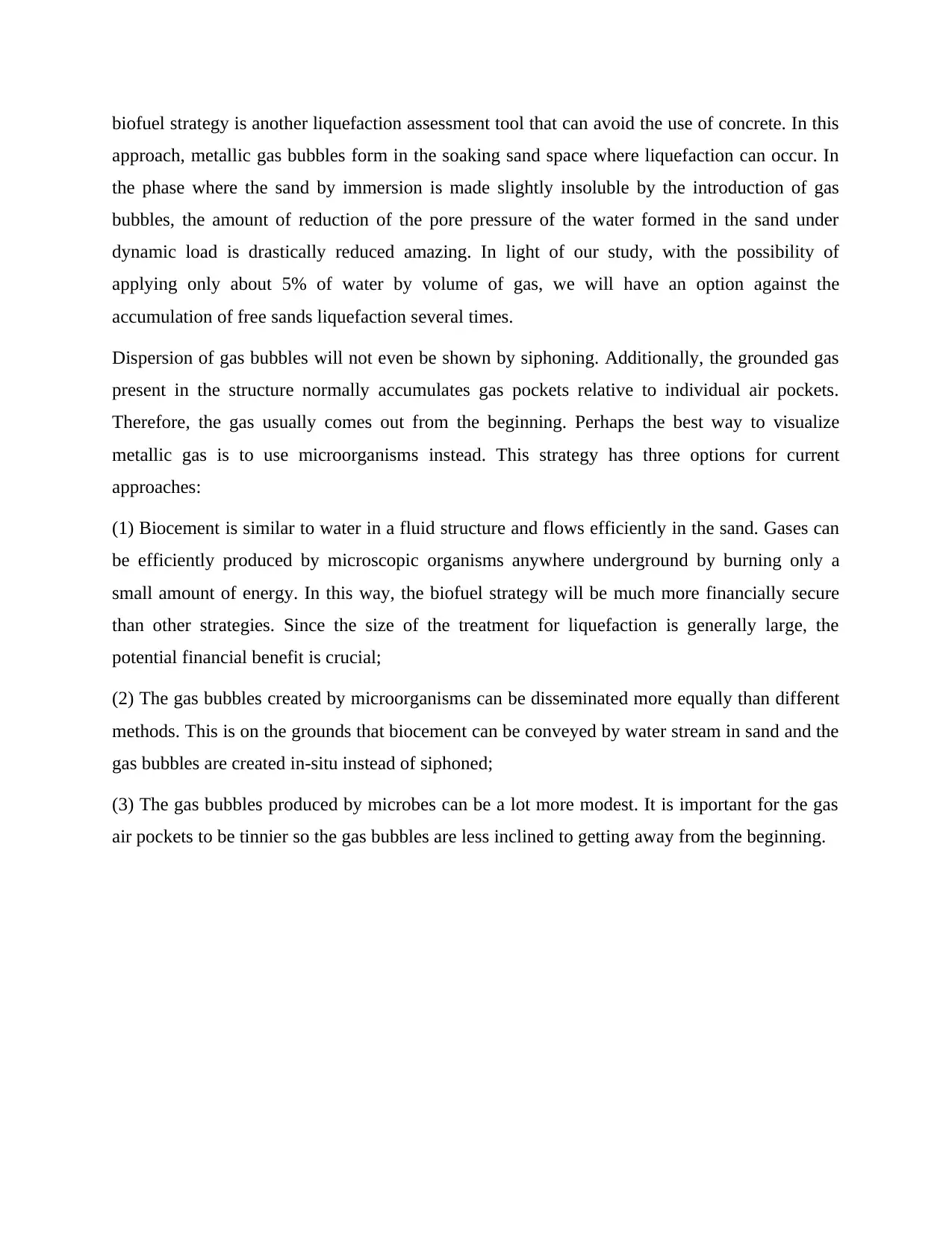
biofuel strategy is another liquefaction assessment tool that can avoid the use of concrete. In this
approach, metallic gas bubbles form in the soaking sand space where liquefaction can occur. In
the phase where the sand by immersion is made slightly insoluble by the introduction of gas
bubbles, the amount of reduction of the pore pressure of the water formed in the sand under
dynamic load is drastically reduced amazing. In light of our study, with the possibility of
applying only about 5% of water by volume of gas, we will have an option against the
accumulation of free sands liquefaction several times.
Dispersion of gas bubbles will not even be shown by siphoning. Additionally, the grounded gas
present in the structure normally accumulates gas pockets relative to individual air pockets.
Therefore, the gas usually comes out from the beginning. Perhaps the best way to visualize
metallic gas is to use microorganisms instead. This strategy has three options for current
approaches:
(1) Biocement is similar to water in a fluid structure and flows efficiently in the sand. Gases can
be efficiently produced by microscopic organisms anywhere underground by burning only a
small amount of energy. In this way, the biofuel strategy will be much more financially secure
than other strategies. Since the size of the treatment for liquefaction is generally large, the
potential financial benefit is crucial;
(2) The gas bubbles created by microorganisms can be disseminated more equally than different
methods. This is on the grounds that biocement can be conveyed by water stream in sand and the
gas bubbles are created in-situ instead of siphoned;
(3) The gas bubbles produced by microbes can be a lot more modest. It is important for the gas
air pockets to be tinnier so the gas bubbles are less inclined to getting away from the beginning.
approach, metallic gas bubbles form in the soaking sand space where liquefaction can occur. In
the phase where the sand by immersion is made slightly insoluble by the introduction of gas
bubbles, the amount of reduction of the pore pressure of the water formed in the sand under
dynamic load is drastically reduced amazing. In light of our study, with the possibility of
applying only about 5% of water by volume of gas, we will have an option against the
accumulation of free sands liquefaction several times.
Dispersion of gas bubbles will not even be shown by siphoning. Additionally, the grounded gas
present in the structure normally accumulates gas pockets relative to individual air pockets.
Therefore, the gas usually comes out from the beginning. Perhaps the best way to visualize
metallic gas is to use microorganisms instead. This strategy has three options for current
approaches:
(1) Biocement is similar to water in a fluid structure and flows efficiently in the sand. Gases can
be efficiently produced by microscopic organisms anywhere underground by burning only a
small amount of energy. In this way, the biofuel strategy will be much more financially secure
than other strategies. Since the size of the treatment for liquefaction is generally large, the
potential financial benefit is crucial;
(2) The gas bubbles created by microorganisms can be disseminated more equally than different
methods. This is on the grounds that biocement can be conveyed by water stream in sand and the
gas bubbles are created in-situ instead of siphoned;
(3) The gas bubbles produced by microbes can be a lot more modest. It is important for the gas
air pockets to be tinnier so the gas bubbles are less inclined to getting away from the beginning.
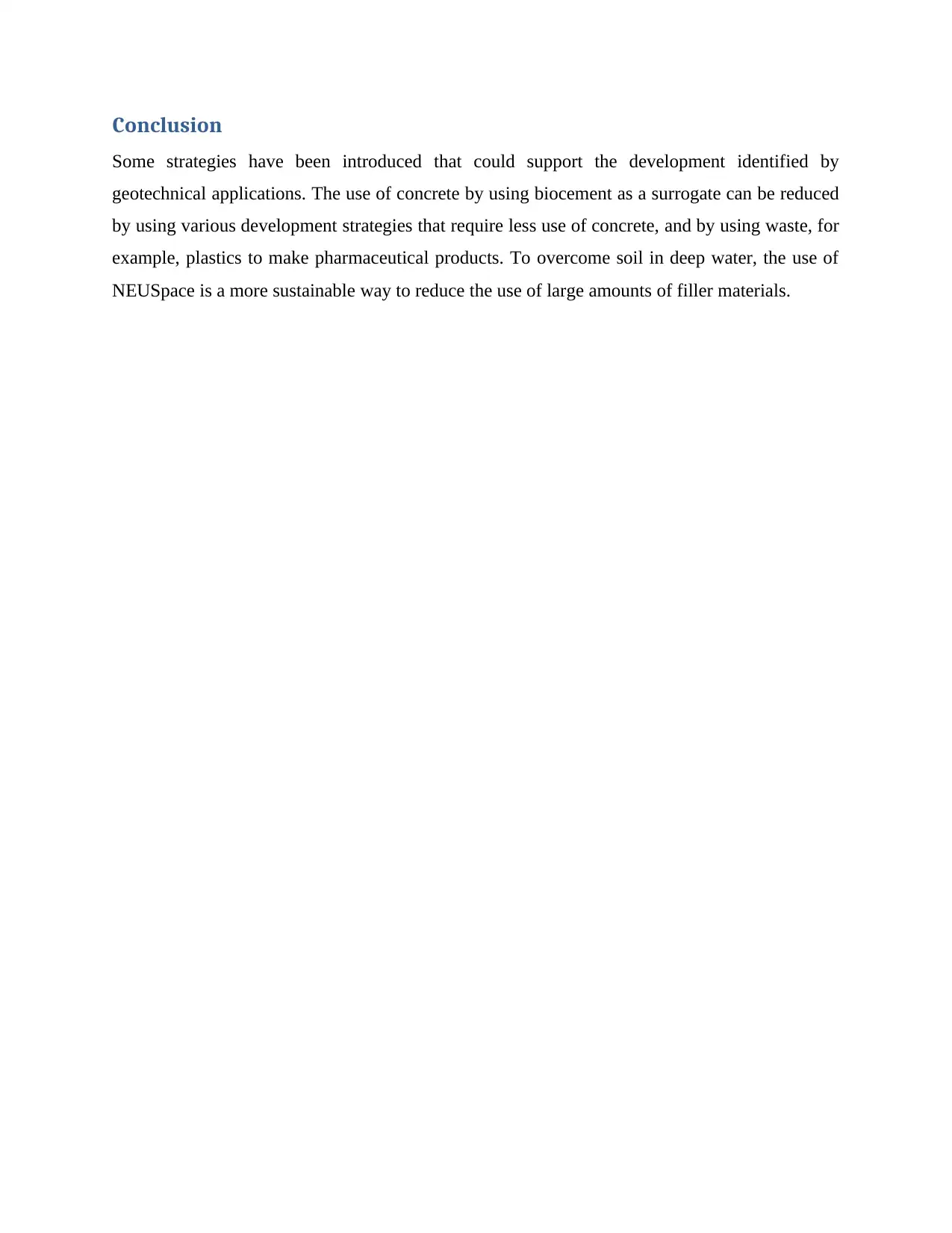
Conclusion
Some strategies have been introduced that could support the development identified by
geotechnical applications. The use of concrete by using biocement as a surrogate can be reduced
by using various development strategies that require less use of concrete, and by using waste, for
example, plastics to make pharmaceutical products. To overcome soil in deep water, the use of
NEUSpace is a more sustainable way to reduce the use of large amounts of filler materials.
Some strategies have been introduced that could support the development identified by
geotechnical applications. The use of concrete by using biocement as a surrogate can be reduced
by using various development strategies that require less use of concrete, and by using waste, for
example, plastics to make pharmaceutical products. To overcome soil in deep water, the use of
NEUSpace is a more sustainable way to reduce the use of large amounts of filler materials.
⊘ This is a preview!⊘
Do you want full access?
Subscribe today to unlock all pages.

Trusted by 1+ million students worldwide
1 out of 13
Related Documents
Your All-in-One AI-Powered Toolkit for Academic Success.
+13062052269
info@desklib.com
Available 24*7 on WhatsApp / Email
![[object Object]](/_next/static/media/star-bottom.7253800d.svg)
Unlock your academic potential
Copyright © 2020–2025 A2Z Services. All Rights Reserved. Developed and managed by ZUCOL.





